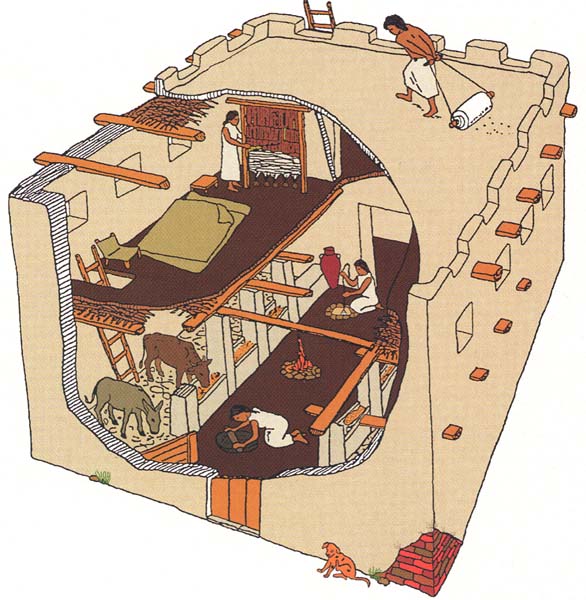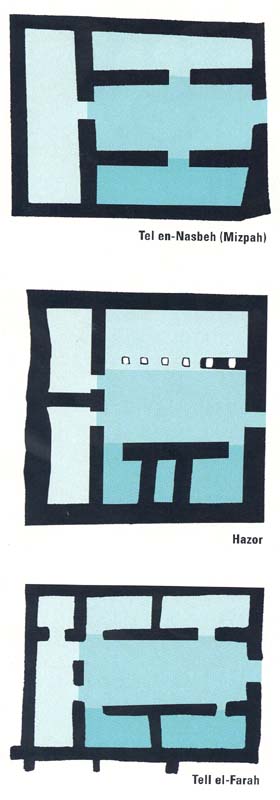Footnotes
On Badè’s excavation at Tell en-Nasbeh, see Jeffrey R. Zorn, “Mizpah: Newly Discovered Stratum Reveals Judah’s Other Capital,” BAR 23:05.
Endnotes
George Ernest Wright, “A Characteristic North Israelite House,” in Archaeology in the Levant: Essays for Kathleen Kenyon, Roger Moorey and Peter Parr, eds., (Warminister: Aris & Phillips, 1978), p. 149.
The origins and architecture of the four-room house and its subtypes—the three- and the five-room house—have been the subject of numerous studies, as has the ethnicity of the inhabitants. See Yigal Shiloh, “The Four-Room House: Its Situation and Function in the Israelite City,” Israel Exploration Journal (IEJ) 20 (1970), pp. 180–190 and “The Four-Room House—The Israelite Type-House?” Eretz-Israel 11 (1973), pp. 277–285 (in Hebrew); also Wright, “A Characteristic North Israelite House,” pp. 149–154; François Braemer, L’architecture domestique du Levant à l’åge du Fer (Paris: éditions Recherches sur les civilizations, 1982); Lawrence E. Stager, “The Archaeology of the Family in Ancient Israel,” Bulletin of the American Schools of Oriental Research (BASOR) 260 (1985) pp. 1–35; John S. Holladay, Jr., “House, Israelite,” in David Noel Freedman, ed., The Anchor Bible Dictionary vol. 3 (New York: Doubleday, 1992), pp. 308–318; John S. Holladay, Jr., “The Four-Room House,” in Eric M. Meyers, ed., The Oxford Encyclopedia of Archaeology in the Near East vol. 2 (New York: Oxford Univ. Press, 1997), pp. 337–341; Ehud Netzer, “Domestic Architecture in the Iron Age,” in Aharon Kempinski and Ronny Reich, eds., The Architecture of Ancient Israel from the Prehistoric to the Persian Period (Jerusalem: Israel Exploration Society, 1992), pp. 193–201.
Volkmar Fritz, “Bestimmung und Herkunft des Pfeinlerhauses in Israel,” Zeitschrift des Deutschen Palästina-Vereins 93 (1977), pp. 30–45; Volkmar Fritz, Tempel und Zelt (Neukirchen-Vluyn: Neukirchen, 1977); Aharon Kempinski, “Tel Masos,” Expedition 20:4 (1978), pp. 29–37; Ze’ev Herzog, Beer-Sheba II: The Early Iron Age Settlements (Tel Aviv: Tel Aviv Univ., 1984), pp. 75–77.
Amihai Mazar, “The Israelite Settlement in Canaan in the Light of Archaeological Excavations,” in Janet Amitai, ed., Biblical Archaeology Today: Proceedings of the International Congress on Biblical Archaeology, Jerusalem, April 1984 (Jerusalem: Israel Exploration Society, 1985), pp. 66–68; Joseph A. Callaway, “Ai (et-Tell): Problem Site for Biblical Archaeologists,” in Leo G. Perdue, Lawrence E. Toombs and Gary L. Johnson, eds., Archaeology and Biblical Interpretation. Essays in Memory of D. Glenn Rose (Atlanta: John Knox, 1987), pp. 87–99; and Shmuel Givon, “The Three-Roomed House from Tel Harassim, Israel,” Levant 31 (1999), pp. 173–77. There are two problems with this idea: The supposed Canaanite “prototypes” lack the broad room, which is essential for the definition of the four-room house type; more importantly, even if some Late Bronze Age architectural ideas were adopted during the Iron Age I period it does not say anything about the meaning of the houses during these periods. People can, and do, adopt cultural elements from other periods and cultures but vest them new and different meaning. See, for example, Abner Cohen, Two Dimensional Man: An essay on the Anthropology of Power and Symbolism in Complex Society (London: Routledge & Kegan Paul), p. 3; Ian Hodder, The Present Past, (London: Batsford, 1982), pp. 204–207.
Lily Singer-Avitz, “Household Activities at Beersheba,” Eretz-Israel 25 (1996), pp. 166–174 (in Hebrew).
Stager, “Archaeology of the Family”; Avraham Faust, “Differences in Family Structure between Cities and Villages in Iron Age II,” Tel-Aviv 26 (1999), pp. 233–252. See also Avraham Faust, “The Rural Community in Ancient Israel during the Iron Age II,” BASOR 318 (2000), p. 17–39.
Keith Branigan, “The Four Room Buildings of Tell en-Nasbeh,” IEJ 16 (1966), pp. 206–209. See also Shiloh, “Four-Room House” and “The Four-Room House-The Israelite Type House?”
Amihai Mazar, “Iron Age Burial Caves North of the Damascus Gate, Jerusalem,” IEJ 26 (1976), p. 4, n. 9; Gabriel Barkai, “Burial Caves and Burial Practices in Judah in the Iron Age,” in Itamar Singer, ed., Graves and Burial Practices in Israel in the Ancient Period (Jerusalem: Yad Izhak Ben Zvi, 1994), p. 149 (in Hebrew); and Gabriel Barkai, “Burial Caves and Dwellings in Judah during Iron Age II: Sociological Aspects,” in Avraham Faust and Aren Meir, eds., Material Culture, Society and Ideology: New Directions in the Archaeology of the Land of Israel (Ramat-Gan: Bar-Ilan University, Department of Land of Israel Studies, 1999), pp. 96–102 (in Hebrew with English abstract).
William G. Dever, “Biblical Archaeology: Death and Rebirth,” in Avraham Biran and Joseph Aviram, eds., Biblical Archaeology Today, 1990. Proceedings of the Second International Congress on Biblical Archaeology, Jerusalem, June-July 1990 (Jerusalem: Israel Exploration Society, 1993), pp. 706–722.
Mohammad M. Ibrahim, “Third Season of Excavation at Sahab” (Preliminary Report), Annual of the Department of Antiquities of Jordan 20 (1975), pp. 69–82; Gusta W. Ahlström, The History of Ancient Palestine from the Palaeolithic Period to Alexander’s Conquest (Sheffield: Sheffield Academic Press, 1993), pp. 339–340; Israel Finkelstein, “Ethnicity and the Origin of the Iron Age I Settlers in the Highlands of Canaan: Can the Real Israel Stand Up?” Biblical Archaeologist 59 (1996), pp. 198–212.
See Avraham Faust, “Ethnic Complexity in Northern Israel during Iron Age II,” PEQ 132 (2000), pp. 2–27. This research demonstrates that the houses were most probably built by Canaanite-Phoenician population.
James R. Kautz, “Tracking the Ancient Moabites,” Biblical Archaeologist 44 (1981), pp. 27–35; P.M. Michèle Daviau, “Domestic Architecture in Iron Age Ammon: Building Materials, Construction Techniques and Room Arrangement,” in Burton MacDonald and Randall W. Younker, eds., Ancient Ammon (Leiden: Brill, 1999), pp. 113–136.
Chang-Ho C. Ji, “The Iron I in Central and Northern Transjordan: An Interim Summary of Archaeological Data,” Palestine Exploration Quarterly 127 (1995), pp. 122–140; and “A Note on the Iron Age Four-Room House in Palestine,” Orientalia 66 (1997), pp. 387–413; Larry G. Herr, “The Settlement and Fortification of Tell al-’Umayri in Jordan during the LB/Iron I Transition,” in Lawrence E. Stager and Michael D. Coogan, eds., The Archaeology of Jordan and Beyond, Essays in Honor of James A. Sauer (Winona Lake, Indiana: Eisenbrauns, 2000), pp. 167–179.
Bill Hillier and Julienne Hanson, The Social Logic of Space (Cambridge: Cambridge Univ., 1984). See also Edward Bruce Banning and Brian F. Byrd, “Alternative Approaches for Exploring Levantine Neolithic Architecture,” Paléorient 15 (1989), pp. 154–160; Sally M. Foster, “Analysis of Spatial Patterns in Buildings (Access Analysis) as an Insight into Social Structure: Examples from the Scottish Atlantic Iron Age,” Antiquity 63 (1989), pp. 40–50; Richard E. Blanton, Houses and Households: A Comparative Study (New York: Plenum, 1994), pp. 24–37.
There is almost a consensus regarding the dating of some of the Biblical laws (including purity laws) to the Iron Age. Many of the laws that are attributed to the Deuteronomist (“D”) are thought to have been written during the late part of that period. The dating of other laws, including the majority of the purity laws, however, is debatable. Most purity laws are attributed to the Priestly source (“P”), and while most scholars have dated P to the Persian period (e.g., Otto Eissfeldt, The Old Testament—An Introduction [Oxford: Blackwell, 1965], pp. 207–208; Alexander Rofe, Introduction to the Composition of the Pentateuch, [Jerusalem: Academon, 1994] [Hebrew]; see also Gordon J. Wenham, The Book of Leviticus, The New International Commentary on the Old Testament [London: Hodder and Stoughton, 1979], pp. 9–11), there is a recent tendency to date it to the Exilic period and to date some, or even most, of its content even earlier (e.g., David J.A. Clines, “Pentateuch,” in The Oxford Companion to the Bible, eds. Bruce M. Metzger and Michael D. Coogan [Oxford: Oxford Univ., 1993], p. 580). Moreover, a growing number of influential scholars date P on various grounds to the Iron Age (e.g., Avi Hurvitz, “The Evidence of Language in Dating the Priestly Code,” Revue Biblique 81 (1974), pp. 24–56; Moshe Weinfeld, “Literary Creativity,” in The World History of the Jewish People, The Age of the Monarchies: Culture and Society, ed. Avraham Malamat (Jerusalem: Massada, 1979), pp. 28–33; Wenham, The Book of Leviticus, p. 13; Richard E. Friedman, Who Wrote the Bible (New York: Summit, 1987); Jacob Milgrom, Leviticus 1–16: A New Translation with Introduction and Commentary, vol. 3 of the Anchor Bible Series (New York: Doubleday, 1991), pp. 12–13; Baruch J. Schwartz, The Holiness Legislation, Studies in the Priestly Code (Jerusalem: Magnes, 1999) pp. 32–33 (in Hebrew).
In this regard, see also Banning and Byrd, “Alternative Approaches for Exploring Levantine Neolithic Architecture,” p. 156; and Frank E. Brown, “Comment on Chapman: Some Cautionary Notes on the Application of Spatial Measures to Prehistoric Settlements,” in Ross Samson, ed., The Social Archaeology of Houses (Edinburgh: Edinburgh Univ., 1990), pp. 103. For the examples, see Avraham Faust, “Ethnic Complexity in Northern Israel during Iron Age II”, PEQ 132 (2000), pp. 2–27.
C. Umhau Wolf, “Traces of Primitive Democracy in Ancient Israel,” Journal of Near Eastern Studies 6 (1947), pp. 98–108; Robert Gordis, “Primitive Democracy in Ancient Israel,” in Poets and Prophets and Sages, Essays in Biblical Interpretation (Bloomington: Indiana Univ., 1971), pp. 45–60; Ephraim Speiser, “The Manner of Kings,” in The World History of the Jewish People, Judges (1971), p. 284; George E. Mendenhall, “The Hebrew Conquest of Palestine,” Biblical Archaeologist 25 (1962), pp. 66–87; and Norman K. Gottwald, The Tribes of Yahweh (New York: Orbis Books, 1979).
Richard Blanton, a leading scholar who has developed this concept of nonverbal communication, divides this phenomenon into two types—canonical and indexical nonverbal communication; see his Houses and Households, pp. 8ff.
Mary Douglas, Purity and Danger. An Analysis of the Concept of Pollution and Taboo (London: Routledge and Kegan Paul, 1966).
Douglas subsequently changed her opinion, suggesting other considerations in the classification of pure and impure creatures (e.g., “The Forbidden Animals in Leviticus,” Journal for the Study of the Old Testament 59 [1993], p. 17). This is part of a broader transformation in her views (Richard Fardon, Mary Douglas: An Intellectual Biography [London: Routledge, 1999], pp. 185–205). It is beyond the scope of this paper to discuss in detail Douglas’s ideas, but her initial interpretation seems to be more in line with the reality of ancient Israelite society (see also Milgrom, Leviticus 1–16, p. 728). In any event, it should be noted that she still stresses the importance of “order.”
See Fredrik Barth, ed., Ethnic Groups and Boundaries (Boston: Little, Brown and Co. 1969); Kathryn Kamp and Norman Yoffee, “Ethnicity in Western Asia during the Early Second Millennium B.C.: Archaeological Assemblages and Ethnoarchaeological Prospectives,” BASOR 237 (1980), pp. 85–104; Ian Hodder, Symbols in Action (Cambridge: Cambridge Univ., 1982a); Randall H. McGuire, “The Study of Ethnicity in Historical Archaeology,” Journal of Anthropological Archaeology 1 (1982), p. 160; Geoff Emberling, “Ethnicity in Complex Societies: Archaeological Perspectives,” Journal of Archaeological Research 5 (1997), p. 299 ; and Siân Jones, The Archaeology of Ethnicity (London: Routledge, 1997), p. 113.








